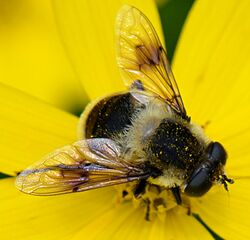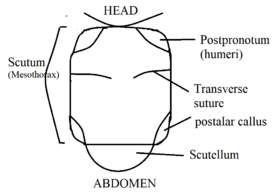Biology:Eristalis anthophorina
| Eristalis anthophorina | |
|---|---|

| |
| Scientific classification | |
| Domain: | Eukaryota |
| Kingdom: | Animalia |
| Phylum: | Arthropoda |
| Class: | Insecta |
| Order: | Diptera |
| Family: | Syrphidae |
| Genus: | Eristalis |
| Species: | E. anthophorina
|
| Binomial name | |
| Eristalis anthophorina (Fallen, 1817)
| |
| Synonyms[1] | |
|
List
| |
Eristalis anthophorina, the orange-spotted drone fly,[2] is a species of syrphid fly with a Holarctic distribution.[1][3][4] It is a common fly in wetlands, including bogs, fens, and woodland pools.[2] In North America, it occurs throughout much of Canada and primarily in the northern parts of the United States.[2] It may be introduced in North America.[3][5]
Distribution
This species is Holarctic in distribution. It is widely distributed worldwide in northern North American and Europe. It is a common in wetlands, including bogs, fens, and woodland pools.[2] In North America, it occurs throughout much of Canada and primarily in the northern parts of the United States.[2] It may be introduced in North America.[3][5] external map
Description
This fly can easily be confused with bumblebees. It reaches around 15 mm (0.6 in) in length.[2]
- Head
The face is reddish-yellow pollinose, with white pilose sides and a shining black median stripe and with black broadly on the cheeks (gena). The antennae are black with the arista reddish and pubescent near the base. The eyes are completely pilose, holoptic in the male
- Thorax
The thorax is black with long yellow hairs. The scutellum is wholly yellow, densely covered with yellow pile.
- Abdomen
The first abdominal segment is black. The second segment is broadly shining with orange spots laterally. The remaining abdomen is black with long yellow-orange pile.
- Wings
The wings are nearly hyaline. The stigmatic spot is dark brown with a broad, distinct, brownish spot in the middle of the wing. Wing veination: sinuous r4+5, closed cell r1 anterior cross- vein (r-m) near the middle of discal cell (dm), oblique.
- Legs
The legs are black, with black pile. The tibia is yellowish at the base.[6] '
Ecology
It has been observed visiting the flowers of Verbena hastata (blue vervain), Salix myricoides (blue-leaved willow), and Hesperis matronalis (dame's rocket).[5]
References
- ↑ 1.0 1.1 ITIS
- ↑ 2.0 2.1 2.2 2.3 2.4 2.5 Skevington, Jeffrey H.; Locke, Michelle M.; Young, Andrew D.; Moran, Kevin; Crins, William J.; Marshall, Stephen A. (2019). Field Guide to the Flower Flies of Northeastern North America. Princeton. ISBN 9780691189406.
- ↑ 3.0 3.1 3.2 "Eristalis anthophorina species information". https://bugguide.net/node/view/18121. Retrieved 2019-09-23.
- ↑ "Eristalis anthophorina". Species. GBIF. http://www.gbif.org/species/1541192.
- ↑ 5.0 5.1 5.2 Wilhelm, Gerould; Rericha, Laura (2017). Flora of the Chicago Region: A Floristic and Ecological Synthesis. Indiana Academy of Sciences.
- ↑ Hull, Frank Montgomery (1925). "A review of the genus Eristalis Latreille in North America". The Ohio Journal of Science 25: 11-45. http://hdl.handle.net/1811/2257.
Wikidata ☰ Q10758922 entry category:Taxa named by Carl Fredrik Fallén






